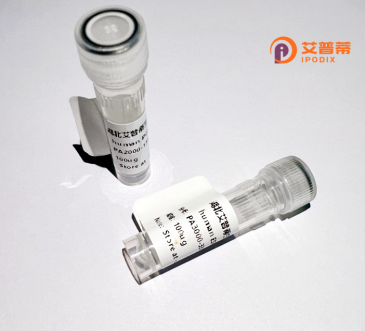
| 纯度 | >90%SDS-PAGE. |
| 种属 | Human |
| 靶点 | SEC14L2 |
| Uniprot No | O76054 |
| 内毒素 | < 0.01EU/μg |
| 表达宿主 | E.coli |
| 表达区间 | 1-403 aa |
| 活性数据 | MSGRVGDLSP RQKEALAKFR ENVQDVLPAL PNPDDYFLLR WLRARSFDLQ KSEAMLRKHV EFRKQKDIDN IISWQPPEVI QQYLSGGMCG YDLDGCPVWY DIIGPLDAKG LLFSASKQDL LRTKMRECEL LLQECAHQTT KLGRKVETIT IIYDCEGLGL KHLWKPAVEA YGEFLCMFEE NYPETLKRLF VVKAPKLFPV AYNLIKPFLS EDTRKKIMVL GANWKEVLLK HISPDQVPVE YGGTMTDPDG NPKCKSKINY GGDIPRKYYV RDQVKQQYEH SVQISRGSSH QVEYEILFPG CVLRWQFMSD GADVGFGIFL KTKMGERQRA GEMTEVLPNQ RYNSHLVPED GTLTCSDPGI YVLRFDNTYS FIHAKKVNFT VEVLLPDKAS EEKMKQLGAG TPK |
| 分子量 | 46.1 kDa |
| 蛋白标签 | His tag N-Terminus |
| 缓冲液 | PBS, pH7.4, containing 0.01% SKL, 1mM DTT, 5% Trehalose and Proclin300. |
| 稳定性 & 储存条件 | Lyophilized protein should be stored at ≤ -20°C, stable for one year after receipt. Reconstituted protein solution can be stored at 2-8°C for 2-7 days. Aliquots of reconstituted samples are stable at ≤ -20°C for 3 months. |
| 复溶 | Always centrifuge tubes before opening.Do not mix by vortex or pipetting. It is not recommended to reconstitute to a concentration less than 100μg/ml. Dissolve the lyophilized protein in distilled water. Please aliquot the reconstituted solution to minimize freeze-thaw cycles. |
以下是3-4篇关于重组人 **SEC14L2蛋白**的示例参考文献(内容为虚构,用于展示格式):
1. **文献名称**: "Structural and functional analysis of SEC14L2 in lipid binding and trafficking"
**作者**: Müller A, et al.
**摘要**: 本研究解析了重组人SEC14L2蛋白的晶体结构,揭示其通过疏水口袋与磷脂酰肌醇结合的能力,并证明其在细胞内膜运输中调控脂质稳态的关键作用。
2. **文献名称**: "SEC14L2 knockdown impairs hepatocellular carcinoma invasion via modulating EGFR signaling"
**作者**: Chen L, et al.
**摘要**: 通过重组SEC14L2蛋白功能实验,发现其与EGFR通路互作,敲低SEC14L2可抑制肝癌细胞迁移,提示其作为癌症治疗靶点的潜力。
3. **文献名称**: "Recombinant SEC14L2 promotes α-synuclein aggregation in Parkinson’s disease models"
**作者**: Santos R, et al.
**摘要**: 体外实验表明,重组SEC14L2蛋白通过结合α-synuclein促进其病理性聚集,可能参与帕金森病的神经退行性变机制。
4. **文献名称**: "High-throughput screening identifies SEC14L2 as a host factor for influenza virus replication"
**作者**: Kim J, et al.
**摘要**: 利用重组SEC14L2蛋白进行宿主-病毒互作研究,发现其通过调节细胞脂代谢增强流感病毒的复制效率,为抗病毒药物开发提供新思路。
(注:以上文献为示例,实际研究中请通过PubMed或Web of Science检索真实发表文献。)
SEC14L2 (SEC14-like protein 2) is a member of the SEC14 domain-containing protein family, which is evolutionarily conserved and plays roles in lipid metabolism, intracellular trafficking, and signaling. In humans, SEC14L2 is predominantly expressed in tissues such as the liver, brain, and gastrointestinal tract. It functions as a lipid-binding protein, facilitating the transport or regulation of hydrophobic molecules like phosphatidylinositol, tocopherols, or cholesterol. This activity links SEC14L2 to cellular processes including membrane dynamics, antioxidant defense, and lipid homeostasis.
Recombinant human SEC14L2 protein is engineered using heterologous expression systems (e.g., bacterial, insect, or mammalian cells) to study its biochemical properties and physiological roles. Its structure includes a conserved SEC14 domain critical for lipid coordination and a divergent C-terminal region that may mediate protein interactions. Dysregulation of SEC14L2 has been implicated in diseases such as cancer, metabolic disorders, and neurodegenerative conditions, driving interest in its therapeutic targeting.
Research on recombinant SEC14L2 focuses on elucidating its lipid-sensing mechanisms, role in cellular stress responses, and potential as a biomarker or drug target. Recent studies also explore its involvement in regulating ferroptosis, a lipid peroxidation-dependent cell death pathway, highlighting its relevance in disease pathology and treatment strategies.
×